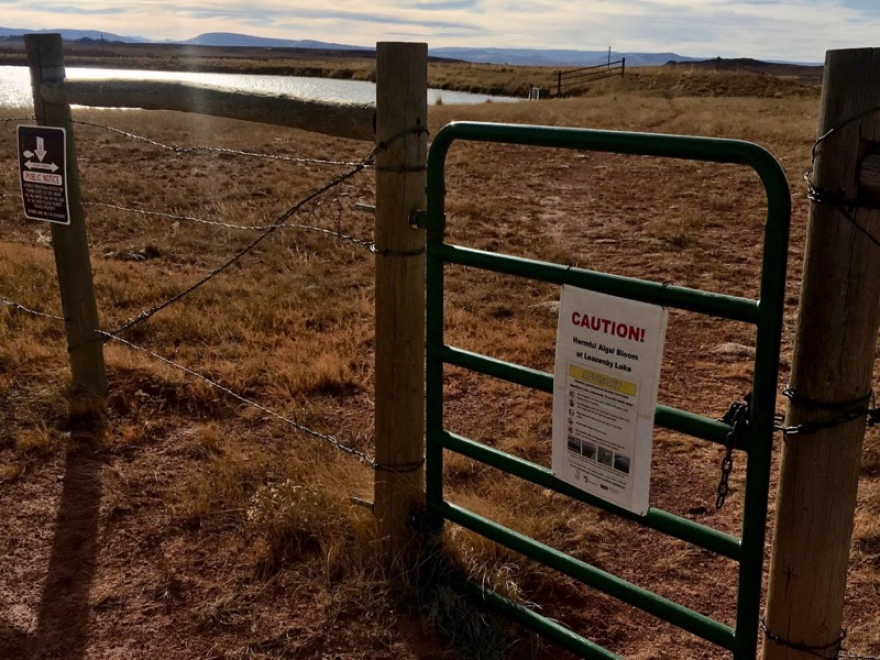One day last June, Susannah Roberts and her boyfriend, Reilly Davis, drove out to Leazenby Lake, just outside of Laramie, Wyoming. They had their black lab Teton with them, and they fished in the clear water.
Roberts remembers Teton running between the two of them, she on the shore and Davis, wearing waders, standing in the water. "And I looked over," Roberts recalls, "and it looked like [Teton] had stumbled."
He'd collapsed, and he couldn't get up. So Roberts and Davis rushed Teton to their veterinarian's office.
"I asked her immediately if it was blue-green algae," Davis says. "It was just on my mind because it matched the symptoms."
Davis knows about those symptoms-seizures, disorientation, difficulty breathing. He's a fish biologist, and spends his summers out in the field. So he sees algae blooms pretty frequently.
"The vet was like, 'I don't know what it is, but you need to go to CSU,'" Roberts says.
That's the animal hospital at Colorado State University 60 miles away in Fort Collins. But about five minutes down the road, Teton died.
"It has just been one of the worst experiences I have ever been through," Roberts says. "One of the positives was that we had each other and that we were both there with him. He knew that we both loved him."
A necropsy confirmed that Teton died from drinking the water in Leazenby Lake, which was contaminated with algae-produced toxins. The water that day was clear-not the bright green typically associated with algae blooms-which demonstrates one of the tricky things about these toxic blooms: they're not always obvious. That's why educating the public about blooms is so important. After Teton died, a sign went up at Leazenby Lake.
It remains there today, hanging on the entrance gate.
Harmful algae blooms are a fairly new phenomenon for public health officials in the Mountain West.
"This summer, I took around 250 calls just from citizens after we would issue a bloom advisory," says Karl Musgrave, Wyoming's state environmental epidemiologist.
Only a few years ago, he says, he'd go an entire summer without a single one of these kinds of calls.
"So why we're seeing a lot of these blooms now? Nobody is really sure on that. It seems related to warmer temperatures, even within a summer."
The blooms need warm temperatures, slow-moving water and certain nutrients to occur. About six years ago, the state didn't even have a way to test for the toxins. Then, calls started coming in from irrigation districts: Is this green-looking water safe?
"That's kind of what prompted it for us," says Lindsay Patterson with the Wyoming Department of Environmental Quality. The agency launched a public education campaign and a website, wyohcbs.org. And she's working with a limited crew to investigate as many water bodies across the state as they can. They can't investigate them all. Plus, it's a moving target.
"It's not like an oil spill, so to speak, like where you can clean it up," Patterson says. "It's one of those things that tends to persist, and the blooms can get worse and they can dissipate. It's just a tough thing to try to figure out the best way to communicate that to the public."
The number of bloom advisories in Wyoming alone went up to 16 this summer. That's compared to 12 in 2018. Patterson says it's hard to make sense of the increase.
"I don't think we necessarily have good information to say there's more now then there was two years ago," she says. "It might just be that we've been made aware of them."
And how big the problem is across the Mountain West is hard to determine, too. That's because no single government agency tracks or monitors the blooms at a national level.
If you suspect a bloom is occurring, public health officials say don't risk it. In other words, if in doubt, stay out.
Have a question about this story? Contact the reporter, Maggie Mullen, at mmullen5@uwyo.edu.
This story was produced by the Mountain West News Bureau, a collaboration between Wyoming Public Media, Boise State Public Radio in Idaho, KUER in Salt Lake City, KUNR in Nevada, the O'Connor Center for the Rocky Mountain West in Montana, and KRCC and KUNC in Colorado.








